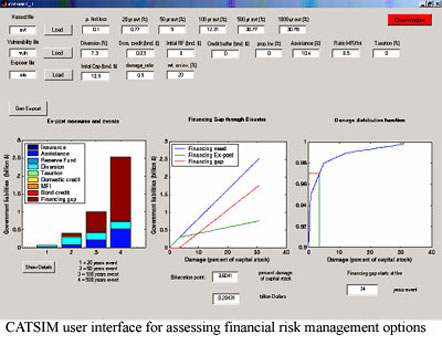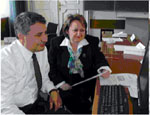Historically, a substantial part of the losses due to disasters in developing countries has been financed by relying on diversions from the budget, as well as loans and donations from the international community. This strategy involves considerable uncertainty with regard to the availability and timeliness of necessary funds, and for this reason emphasis is being put on financial planning.
This research activity develops the RPV model framework (CATSIM) to assess the financial vulnerability of the public sector to extreme events in hazard-prone developing countries and to illustrate the tradeoffs and choices a country government must make in managing the economic risks due to natural disasters.
RPV research on financial vulnerability is based on a study carried out for the Natural Disasters Management Network of the Regional Policy Dialogue of the Inter-American Development Bank (IDB). For the first time, an approach has been developed and applied to identify countries with a potential financing gap (representing the financial vulnerability to extreme events), that is, countries where disasters have the potential to swamp the governments ability to finance the recovery process.

RPV's CATSIM (CATastrophe SIMulation) can assist policy makers in developing public financing strategies for disaster risk. The models shows the respective costs and consequences of financing alternatives on important indicators, for example, economic growth or debt. The model is equipped with a graphical interface that allows the user to change default parameters defining hazards, vulnerability and the elements exposed. There are two modules: the first assesses risk and the second shows the costs and benefits of different strategies to manage risk. Since the user can interactively change parameters and assumptions, financial strategies are shown in a transparent fashion. Furthermore, in another mode an optimal mix of ex-ante and ex-post measures can be calculated by solving a multistage stochastic optimization problem.
CATSIM has been used in a number of policy workshops in Honduras (2004), at IIASA (2004), in the Philippines (2006) and in the Caribbean (2006).
 The IIASA workshop was the first to involve multiple countries. It was sponsored by the World Bank's Hazard Management (HMU) and the ProVention Consortium. Policy makers and practitioners from Colombia, Mexico, India, the Philippines, and Turkey interacted with IIASA and World Bank staff and consultants. The purpose of the workshop was to exchange insights and practice on loss-mitigation and pre-disaster financial strategies for reducing the vulnerability of the public and private sectors to the economic losses of disasters. Each of the participating countries is advanced in pre-disaster financial planning, or is considering developing advanced schemes.
The IIASA workshop was the first to involve multiple countries. It was sponsored by the World Bank's Hazard Management (HMU) and the ProVention Consortium. Policy makers and practitioners from Colombia, Mexico, India, the Philippines, and Turkey interacted with IIASA and World Bank staff and consultants. The purpose of the workshop was to exchange insights and practice on loss-mitigation and pre-disaster financial strategies for reducing the vulnerability of the public and private sectors to the economic losses of disasters. Each of the participating countries is advanced in pre-disaster financial planning, or is considering developing advanced schemes.
The workshop demonstrated the potential of CATSIM for building the capacity of policy makers to evaluate ex-ante financial instruments, including insurance, catastrophe bonds, contingent credit arrangements and other disaster hedges, and compare their benefits with investments in loss reduction.
In a one day hands-on exercise as part of a recent two-day workshop on budgetary and financial approaches to disaster risk management in Barbados, senior representatives of Ministries of Finance and Planning, and National Disaster Coordinators from 18 Caribbean countries used CATSIM to develop strategies for financially coping with disaster risk. At this workshop, which was organized by the IDB and the Caribbean Development Bank (CDB), CATSIM was useful for putting into practice the workshop concepts and approaches for incorporating disaster risk management into fiscal and development planning, as well as exploring the feasibility of physical and financial disaster risk management options. At the request of participants, CATSIM was distributed to 10 Caribbean countries as well as CDB and IDB staff.
Future work on CATSIM is focusing on assessing costs and benefits of adaptation to climate change (within ADAM) and integrating spatially explicit information in order to more realistically represent risk reduction options.
For more information, contact Reinhard Mechler.Responsible for this page: Jun Watabe
Last updated:
24 Feb 2011
Phone: (+43 2236) 807 0
Copyright © 2009-2011 IIASA